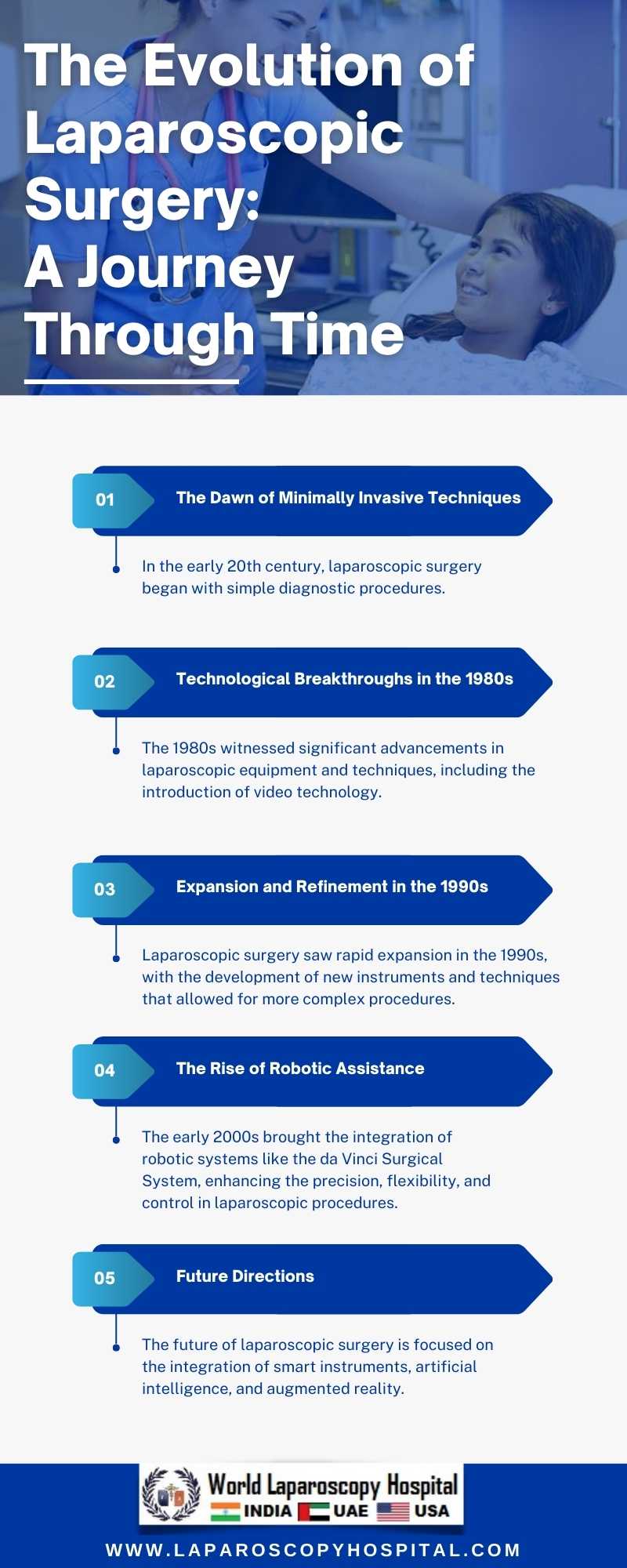The Evolution of Laparoscopic Surgery: A Journey Through Time
The evolution of laparoscopic surgery represents a remarkable journey through time, transforming the landscape of surgical practices and significantly impacting patient care. This journey begins in the early 20th century and continues to evolve with advancements in technology and surgical techniques.

The inception of laparoscopic surgery can be traced back to the early 1900s when Georg Kelling of Dresden, Germany, performed the first laparoscopic procedure on a dog using a Nitze cystoscope. He introduced air into the abdominal cavity to create a pneumoperitoneum, which is now a fundamental step in laparoscopic procedures. This pioneering work laid the foundation for future developments, although widespread adoption was initially slow due to technological limitations and skepticism from the surgical community.
The field began to gain momentum in the 1960s and 1970s with the introduction of improved optical devices and the development of the rod-lens system by Harold Hopkins. This innovation provided surgeons with a clearer view of the internal organs, significantly enhancing the precision and safety of laparoscopic procedures. Additionally, the development of carbon dioxide insufflators to maintain the pneumoperitoneum and advances in electronic imaging further propelled the field forward.
A landmark moment in the evolution of laparoscopic surgery occurred in 1987 when Dr. Philippe Mouret, a French surgeon, performed the first laparoscopic cholecystectomy, the removal of the gallbladder through small incisions. This procedure demonstrated the potential of laparoscopic techniques to reduce postoperative pain, shorten hospital stays, and improve cosmetic outcomes, leading to a rapid expansion in the application of laparoscopy across various surgical disciplines.
The 1990s and early 2000s saw the integration of laparoscopic surgery into the fields of gynecology, urology, and general surgery, among others. Procedures such as appendectomies, hernia repairs, and colorectal surgeries became routinely performed laparoscopically. The development of high-definition cameras, better insufflation devices, and specialized instruments, including articulating and energy devices, further enhanced the surgeon's ability to perform complex procedures with greater precision and control.
In recent years, the advent of robotic-assisted laparoscopic surgery has marked a new era in the field. Robotic systems, such as the da Vinci Surgical System, offer surgeons enhanced dexterity, precision, and visualization, allowing for even more complex surgeries to be performed minimally invasively. The integration of artificial intelligence and machine learning is poised to further revolutionize laparoscopic surgery by providing real-time analytics, improved decision-making, and personalized surgical planning.
The journey of laparoscopic surgery from its humble beginnings to its current state as a cornerstone of modern surgical practice is a testament to the relentless pursuit of innovation and improvement in patient care. As technology continues to advance, the future of laparoscopic surgery promises even greater possibilities, including augmented reality guidance, nanotechnology, and further integration of robotic systems, ensuring that this journey is far from over.

The inception of laparoscopic surgery can be traced back to the early 1900s when Georg Kelling of Dresden, Germany, performed the first laparoscopic procedure on a dog using a Nitze cystoscope. He introduced air into the abdominal cavity to create a pneumoperitoneum, which is now a fundamental step in laparoscopic procedures. This pioneering work laid the foundation for future developments, although widespread adoption was initially slow due to technological limitations and skepticism from the surgical community.
The field began to gain momentum in the 1960s and 1970s with the introduction of improved optical devices and the development of the rod-lens system by Harold Hopkins. This innovation provided surgeons with a clearer view of the internal organs, significantly enhancing the precision and safety of laparoscopic procedures. Additionally, the development of carbon dioxide insufflators to maintain the pneumoperitoneum and advances in electronic imaging further propelled the field forward.
A landmark moment in the evolution of laparoscopic surgery occurred in 1987 when Dr. Philippe Mouret, a French surgeon, performed the first laparoscopic cholecystectomy, the removal of the gallbladder through small incisions. This procedure demonstrated the potential of laparoscopic techniques to reduce postoperative pain, shorten hospital stays, and improve cosmetic outcomes, leading to a rapid expansion in the application of laparoscopy across various surgical disciplines.
The 1990s and early 2000s saw the integration of laparoscopic surgery into the fields of gynecology, urology, and general surgery, among others. Procedures such as appendectomies, hernia repairs, and colorectal surgeries became routinely performed laparoscopically. The development of high-definition cameras, better insufflation devices, and specialized instruments, including articulating and energy devices, further enhanced the surgeon's ability to perform complex procedures with greater precision and control.
In recent years, the advent of robotic-assisted laparoscopic surgery has marked a new era in the field. Robotic systems, such as the da Vinci Surgical System, offer surgeons enhanced dexterity, precision, and visualization, allowing for even more complex surgeries to be performed minimally invasively. The integration of artificial intelligence and machine learning is poised to further revolutionize laparoscopic surgery by providing real-time analytics, improved decision-making, and personalized surgical planning.
The journey of laparoscopic surgery from its humble beginnings to its current state as a cornerstone of modern surgical practice is a testament to the relentless pursuit of innovation and improvement in patient care. As technology continues to advance, the future of laparoscopic surgery promises even greater possibilities, including augmented reality guidance, nanotechnology, and further integration of robotic systems, ensuring that this journey is far from over.
2 COMMENTS
Dr. Roma Varadkar
#1
Feb 14th, 2024 8:13 am
Laparoscopic surgery's evolution from its origins to a cornerstone of modern practice reflects innovation's impact on patient care. Advancing technology heralds augmented reality, nanotechnology, and enhanced robotics, promising a future ripe with possibilities for continued improvement in surgical care.
Dr. Baljeet Kaur
#2
Feb 27th, 2024 5:33 pm
The evolution of laparoscopic surgery reflects relentless innovation in patient care. From its origins to a cornerstone of modern practice, it's a testament to progress. With advancing technology, future prospects like augmented reality, nanotechnology, and robotic integration ensure this journey persists.
| Older Post | Home | Newer Post |





